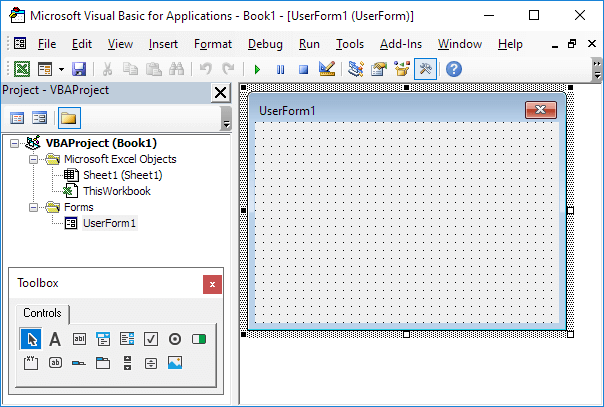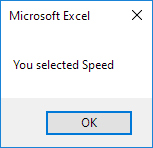Multicolumn Combo Box in Excel VBA
Below we will look at a program in Excel VBA which creates a Userform that contains a multicolumn combo box.
The Userform we are going to create looks as follows:

To create this Userform, execute the following steps.
1. Open the Visual Basic Editor. If the Project Explorer is not visible, click View, Project Explorer.
2. Click Insert, Userform. If the Toolbox does not appear automatically, click View, Toolbox. Your screen should be set up as below.

3. Add the label, combo box and command buttons. Once this has been completed, the result should be consistent with the picture of the Userform shown earlier. For example, create a combo box control by clicking on ComboBox from the Toolbox. Next, you can drag a combo box on the Userform.
4. You can change the names and the captions of the controls. Names are used in the Excel VBA code. Captions are those that appear on your screen. It is good practice to change the names of the controls, but it is not necessary here because we only have a few controls in this example. To change the caption of the Userform, label and command buttons, click View, Properties Window and click on each control.
5. To show the Userform, place a command button on your worksheet and add the following code line:
UserForm1.Show
End Sub
We are now going to create the Sub UserForm_Initialize. When you use the Show method for the Userform, this sub will automatically be executed.
6. Open the Visual Basic Editor.
7. In the Project Explorer, right click on UserForm1 and then click View Code.
8. Choose Userform from the left drop-down list. Choose Initialize from the right drop-down list.
9. Add the following code lines:
ComboBox1.ColumnCount = 2
Dim Films(1 To 5, 1 To 2) As String
Dim i As Integer, j As Integer
Films(1, 1) = "Lord of the Rings"
Films(2, 1) = "Speed"
Films(3, 1) = "Star Wars"
Films(4, 1) = "The Godfather"
Films(5, 1) = "Pulp Fiction"
Films(1, 2) = "Adventure"
Films(2, 2) = "Action"
Films(3, 2) = "Sci-Fi"
Films(4, 2) = "Crime"
Films(5, 2) = "Drama"
ComboBox1.List = Films
End Sub
Explanation: The first code line sets the number of columns of the combo box to 2. Instead of setting the number of columns at runtime, you can also configure this setting at design time. To achieve this, right mouse click on the combo box control, click Properties and set the ColumnCount property to 2. Next, we declare and initialize a two-dimensional array. The last code line assigns the array to the combo box.
We have now created the first part of the Userform. Although it looks neat already, nothing will happen yet when we click the command buttons on the Userform.
10. In the Project Explorer, double click on UserForm1.
11. Double click on the OK button.
12. Add the following code lines:
Unload Me
MsgBox "You selected " & ComboBox1.Value
On Error Resume Next
MsgBox "You like " & ComboBox1.Column(1) & " movies"
End Sub
Note: these code lines close the Excel VBA Userform and display the selected item and genre. The 'On Error Resume Next' statement ignores the error when the user fills in his/her own movie (in this case there is no genre available).
13. Double click on the Cancel button.
14. Add the following code line:
Unload Me
End Sub
Result when you select Speed and click OK.

